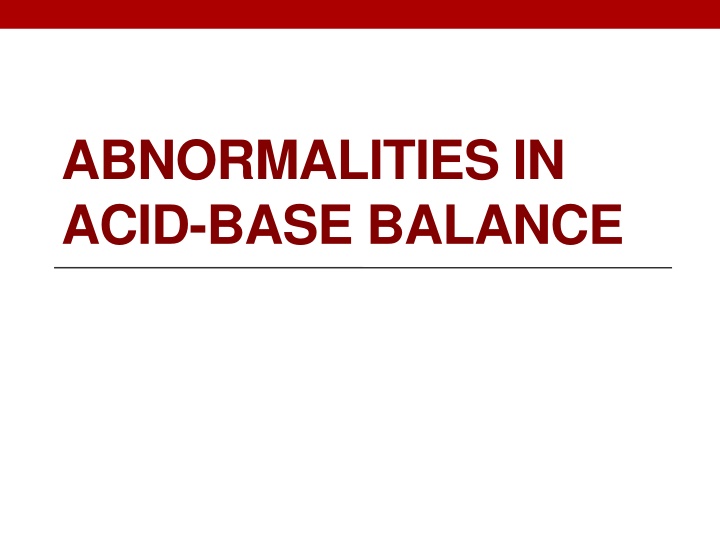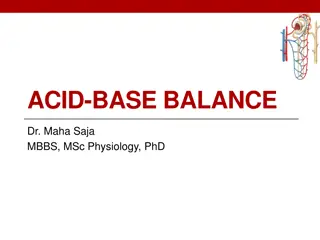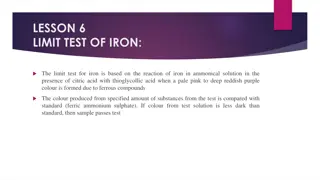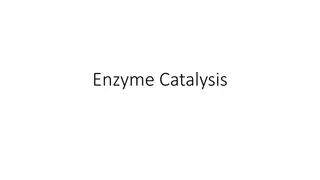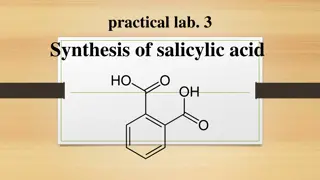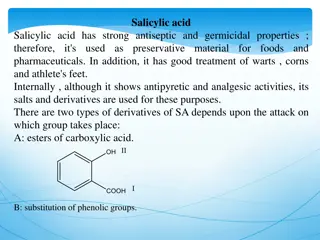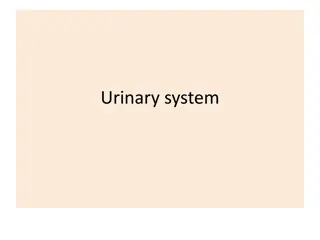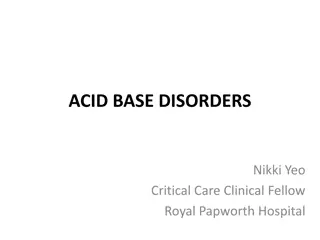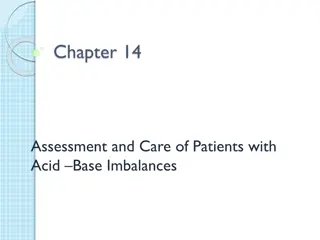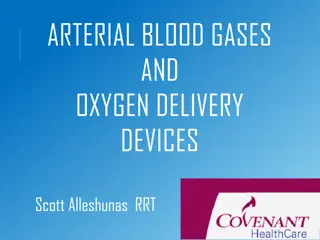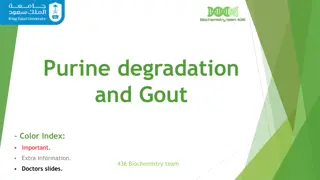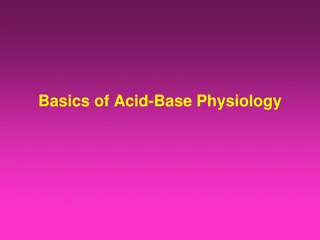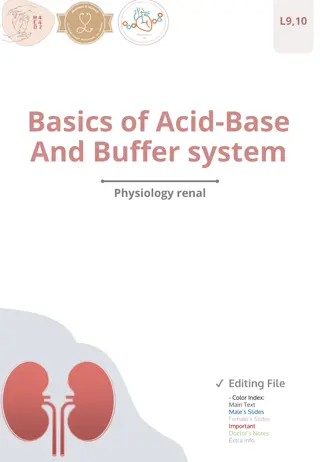Acid-Base Balance in Health and Disease
Many critical illnesses can disrupt acid-base balance, indicating underlying diseases or organ damage. Interpretation of disturbances requires analyzing arterial blood gases, plasma electrolytes, and compensatory mechanisms. Acid-base disorders are classified into respiratory acidosis, respiratory alkalosis, metabolic acidosis, and metabolic alkalosis, with the body attempting to compensate for these disturbances. Primary causes include respiratory conditions, metabolic imbalances, and various health conditions affecting ventilation or electrolyte balance.
Download Presentation

Please find below an Image/Link to download the presentation.
The content on the website is provided AS IS for your information and personal use only. It may not be sold, licensed, or shared on other websites without obtaining consent from the author.If you encounter any issues during the download, it is possible that the publisher has removed the file from their server.
You are allowed to download the files provided on this website for personal or commercial use, subject to the condition that they are used lawfully. All files are the property of their respective owners.
The content on the website is provided AS IS for your information and personal use only. It may not be sold, licensed, or shared on other websites without obtaining consent from the author.
E N D
Presentation Transcript
ABNORMALITIES IN ACID-BASE BALANCE
Abnormalities in Acid-Base Balance Many critical illnesses can disturb acid-base balance. Acid-base disturbances may indicate an underlying disease or organ damage. Accurate interpretation of acid-base disturbances requires the following: Arterial blood gases. Plasma electrolytes. Knowledge of the compensatory physiologic mechanisms. (Appel & Downs. 2008. Understanding acid-base balance)
Abnormalities in Acid-Base Balance Acidosis Alkalosis HCO3 PCO2 HCO3- HCO3- PCO2 PCO2 Respiratory Metabolic Respiratory Metabolic
Fundamentals in Acid-Base Disorders Acid-base disorders are classified by changes in pH, PCO2 and HCO3- There are 4 primary acid-base disorders: Respiratory acidosis: PCO2 Respiratory alkalosis: PCO2 Metabolic acidosis: [HCO3-] Metabolic alkalosis: [HCO3-] The body normally attempts to correct the primary acid- base disturbances by a secondary or compensatory response trying to restore pH towards normal. The kidneys compensate for primary respiratory disorders. The lungs compensate for primary metabolic disorders. (Dooley & Sisson. Acid-base disorders)
Primary Acid-Base Disturbances Primary acid-base disorders Alkalosis Acidosis Respiratory Metabolic Respiratory Metabolic Decreased ventilation Inhibition of respiratory center Lung damage Airway obstruction COPD Loss of HCO3- or gain of H+ Renal tubular acidosis Diarrhea Diabetes Ingestion of acids (alcohol or aspirin) Ch. renal failure Increased ventilation Psychoneurosis High altitude Mechanical overventilation Pregnancy Excess HCO3- or loss of H+ Diuretics except CAI Hyperaldosteronism Vomiting gastric contents Ingestion of antacids
Respiratory Acidosis Respiratory acidosis = pH + PCO2 Due to alveolar hypoventilation. Depression of respiratory center Opioid ingestion Head injury Causes of respiratory acidosis Alveolar hypoventilation Lung disease COPD Pneumonia Pulmonary edema
Respiratory Alkalosis Respiratory alkalosis = pH + PCO2 Due to alveolar hyperventilation. Mechanical hyperventilation Causes of respiratory alkalosis Alveolar hyperventilation Anxiety
Metabolic Alkalosis Metabolic alkalosis = pH + [HCO3-] Due to loss of acids. Due to gain of HCO3- Vomiting gastric contents Loss of acids Loop & thiazide diuretics Hyperaldosteronism. Causes of metabolic alkalosis Ingestion or administration of alkaline products Gain of HCO3- (Appel & Downs. 2008. Understanding acid-base balance; Dooley & Sisson. Acid-base disorders)
Metabolic Acidosis Metabolic acidosis = pH due to [HCO3-] Due to acid gain. Due to loss of HCO3 acid production Lactic acidosis Diabetic ketoacidosis Salicylate poisoning Starvation Gain of acids acid elimination Renal failure Causes of metabolic acidosis Through kidneys RTA CAI Aldosterone deficiency Through GIT Diarrhea Loss of HCO3- (Appel & Downs. 2008. Understanding acid-base balance; Dooley & Sisson. Acid-base disorders)
Compensatory Mechanisms Primary Disturbance Compensatory Mechanism Respiratory Acidosis Increase HCO3 Respiratory Alkalosis Decrease HCO3 Metabolic Acidosis Decrease PCO2 Metabolic Alkalosis Increase PCO2
Interpretation of Acid-Base Disturbances Normal values; pH =7.35-7.45 PCO2 =35-45 mmHg HCO3-= 22-28 mmol/L
Simple Acid-Base Disturbances pH PCO2 (mmHg) HCO3 (mEq/L) Normal 7.35-7.45 35-45 22-28 Respiratory acidosis Decrease Increase Increase Respiratory alkalosis Increase Decrease Decrease Metabolic acidosis Decrease Decrease Decrease Metabolic alkalosis Increase Increase Increase
Case study 1 A patient known to have COPD presented with 3-day history of fever, SOB, and cough productive of yellowish sputum. His ABGs showed: pH = 7.25 PCO2 = 80 mmHg. [HCO3-] = 34 mEq/L.
Case study 2 A 21 year old man with IDDM presents to ER with mental status changes, nausea, vomiting, abdominal pain and rapid respirations. His ABGs showed: pH = 7.2 PCO2 = 20 mmHg [HCO3-] = 8 mEq/l
Case study 3 A 2-year old child who is lethargic and dehydrated has a 3-day history of vomiting. His ABGs showed: pH = 7.56 PCO2 = 44 mmHg [HCO3-] = 37 mEq/l
Case study 4 A 20-year old student suffered a panic attack while awaiting an exam. Her ABGs showed: pH = 7.6 PCO2 = 24 mmHg. [HCO3-] = 23 mEq/L.
Other Acid-Base Disorders Simple acid-base disorders Mixed acid-base disorders Result from a single primary abnormality with appropriate physiologic compensation. Result from multiple primary processes.
Mixed Acid-Base Disturbances Occurs when a patient has more than one primary acid base disorder that occur at the same time. Examples: Respiratory alkalosis/acidosis along with a metabolic acidosis/alkalosis. Two metabolic acid-base disorders occurring simultaneously.
Case study 5 A 69 year old patient known to have COPD presented with a 3-day history of abdominal pain and diarrhea. His ABGs showed; pH = 6.96 PCO2 = 55mmHg [HCO3-] = 12 mmol/L
